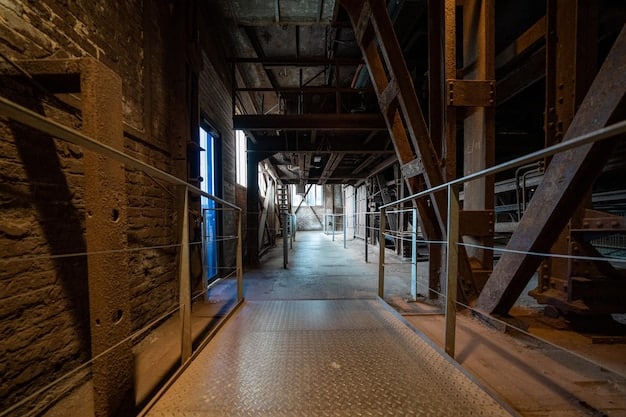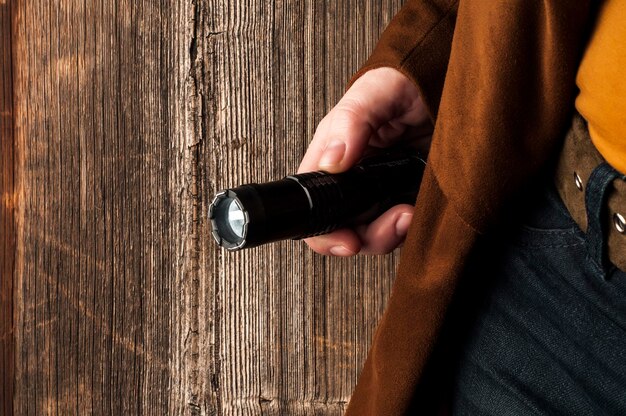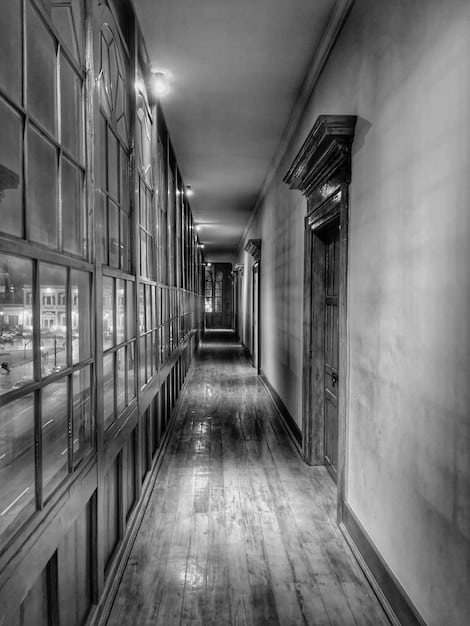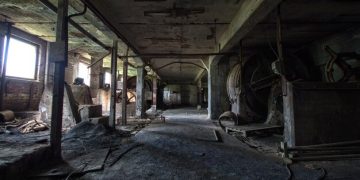Urban Exploration in the US: Unveiling Risks, Rewards & Abandoned Spaces

Urban exploration in the US, often called “urbex,” offers a unique blend of adventure and historical discovery, attracting enthusiasts to explore abandoned structures while confronting inherent risks and ethical considerations.
Delving into the realm of urban exploration in the US reveals a captivating subculture where adventurers seek the thrill of discovering forgotten spaces and hidden histories.
The Allure of the Abandoned: Understanding Urban Exploration
Urban exploration, often shortened to “urbex,” is the act of venturing into man-made structures, usually abandoned or off-limits. In the US, this activity has gained considerable traction, drawing in people from all walks of life who are intrigued by the stories held within these decaying walls.
But what exactly makes these forgotten spaces so alluring?
Historical Curiosity and Discovery
Many urban explorers are driven by a desire to uncover hidden histories. Abandoned buildings, factories, hospitals, and other locations offer tangible links to the past, providing insights into bygone eras and the lives of those who once inhabited them.
The Thrill of Adventure
Urbex provides a sense of adventure that is hard to replicate in everyday life. Navigating through dilapidated structures, overcoming obstacles, and discovering hidden rooms can be incredibly exhilarating.

Photography and Artistic Expression
For many, urbex is a means of artistic expression. The unique aesthetics of abandoned spaces—characterized by decay, graffiti, and the interplay of light and shadow—offer endless opportunities for stunning photography and visual storytelling.
- Personal stories: Urbex often triggers a personal connection to the past, allowing individuals to reflect on personal history or the broader historical context of the explored site.
- Sense of Freedom: Many urbex enthusiasts appreciate the feeling of freedom and autonomy that comes with exploring forgotten places.
- Challenge and Exploration: Navigating challenging terrains in Urbex creates an adrenaline rush, along with the excitement of discovering hidden spaces.
Ultimately, the appeal of urban exploration lies in its ability to combine adventure, history, and art into a unique and unforgettable experience. However, it’s essential to be aware of the risks involved and to approach each exploration with respect and responsibility.
Navigating the Risks: Safety First in Urbex
While the allure of urban exploration is undeniable, it’s crucial to acknowledge the inherent risks involved. Abandoned buildings are often structurally unsound, hazardous, and potentially dangerous. Prioritizing safety is paramount for any urbex enthusiast.
What are the key risks associated with urban exploration?
Structural Hazards and Physical Dangers
Abandoned buildings are often in a state of disrepair. Collapsing floors, unstable walls, exposed wiring, and broken glass are just some of the hazards that explorers may encounter. It’s essential to exercise caution and assess the structural integrity of a building before entering.
Environmental Hazards and Health Risks
Abandoned spaces can harbor a variety of environmental hazards, including asbestos, mold, lead paint, and contaminated water. These substances can pose significant health risks, especially with prolonged exposure.
Legal Consequences and Security Concerns
Entering abandoned or off-limits properties can result in legal consequences, including trespassing charges and fines. Additionally, many abandoned sites are patrolled by security personnel who may not take kindly to trespassers.
- Research is Key: Investigate the history of the location and any known hazards before visiting.
- Gear Up: Always wear sturdy footwear, gloves, and protective clothing. A mask can protect you from inhaling mold or asbestos.
- Buddy System: Never explore alone. Go with a friend or group to ensure someone can assist in case of an accident.
- First Aid: Carry a well-stocked first-aid kit and know basic first-aid procedures.
By acknowledging and mitigating these risks, urban explorers can minimize the potential for accidents and ensure a safer, more enjoyable experience. Always remember, safety should never be compromised for the sake of adventure.
The Ethics of Exploration: Respecting Boundaries and History
Beyond the physical and legal risks, urban exploration also raises ethical questions. It’s essential for explorers to act responsibly, respecting the boundaries of the sites they visit and the history they contain.
What ethical considerations should guide urban exploration?
“Take Nothing but Pictures, Leave Nothing but Footprints”
This is the mantra of responsible urban explorers. Removing artifacts, damaging property, or leaving behind trash is unacceptable. The goal should be to document the site respectfully, leaving it as you found it.
Respecting Private Property and “No Trespassing” Signs
Ignoring “No Trespassing” signs or entering private property without permission is unethical and illegal. Always respect the rights of property owners, even if a building appears abandoned.
Preserving Historical Integrity
Abandoned sites are often repositories of historical information. Vandalizing or defacing these sites destroys valuable historical context, depriving future generations of the opportunity to learn from the past.

Avoiding Sensationalism and Exploitation
Sharing images and stories of urban exploration can be a great way to raise awareness and appreciation for forgotten spaces. However, it’s important to avoid sensationalizing or exploiting these sites for personal gain. For example, do not post the location in a public forum.
- Seek Permission: If possible, obtain permission from the property owner before entering an abandoned site.
- Preserve: If you find historical artifacts or documents, leave them undisturbed. Document their existence through photography, but do not remove them.
- Share Responsibly: When sharing your experiences online, be mindful of the information you disclose. Avoid revealing sensitive details that could encourage vandalism or disrespectful behavior.
By adhering to ethical principles, urban explorers can ensure that their activities are both respectful and sustainable. Ultimately, responsible exploration helps to preserve these fascinating sites for future generations to appreciate and learn from.
Urban Exploration as Art and Documentation
Urban exploration is not solely about trespassing and adventure; it is also a unique form of art and documentation. For many, the act of exploring and preserving these forgotten spaces is a creative endeavor.
How does urban exploration contribute to art and documentation?
Capturing Decay and Beauty: Photography in Urbex
Photography is an integral part of urban exploration. The decaying beauty of abandoned spaces provides endless opportunities for capturing stunning images that tell stories of history, neglect, and resilience.
Documenting History: Preserving Urban Narratives
Urban explorers often become accidental historians, documenting the stories of abandoned buildings and the people who once inhabited them. These explorations provide valuable insights into the past, preserving urban narratives for future generations.
Creative Expression: Graffiti and Urban Art
Many abandoned spaces are adorned with graffiti and urban art. While some may view this as vandalism, others see it as a legitimate form of creative expression that adds to the unique character of these sites.
- Photography Techniques: Exploring different lighting techniques, perspectives, and compositions to capture the essence of abandoned spaces.
- Historical Research: Digging into the history of the location to learn about the people who lived or worked there.
- Collaboration with Local Communities: Working with local communities to share stories and preserve the history of abandoned sites.
Urban exploration, when approached responsibly, can be a powerful tool for artistic expression and historical documentation. By capturing images, preserving stories, and respecting the sites they visit, urban explorers contribute to a greater understanding and appreciation of our urban landscape.
The Future of Urbex: Challenges and Preservation
As urban exploration continues to grow in popularity, it faces a number of challenges. Preservation efforts, changing urban landscapes, and the need for responsible exploration all play a role in shaping the future of this unique subculture.
What challenges and opportunities lie ahead for urbex?
Balancing Exploration and Preservation
One of the biggest challenges facing the urbex community is balancing the desire for exploration with the need to preserve abandoned sites. As more people become interested in urbex, there is a greater risk of vandalism and damage to these locations.
Changing Urban Landscapes
Urban landscapes are constantly evolving. Many abandoned buildings are demolished to make way for new construction, while others are renovated and repurposed. This means that the opportunities for urban exploration are constantly changing.
Educating New Explorers
As the urbex community grows, it is essential to educate new explorers about the risks, ethics, and responsibilities associated with this activity. Promoting responsible exploration is crucial for preserving abandoned sites and ensuring the safety of explorers.
- Local Regulations: Staying informed of local laws and regulations regarding access to abandoned properties.
- Community Support: Engaging with local communities to gain support for preservation efforts.
- Technology: Using technology, such as 3D scanning and virtual reality, to document and share abandoned spaces.
The future of urban exploration depends on the ability of the community to address these challenges and seize the opportunities that lie ahead. By promoting responsible exploration, supporting preservation efforts, and embracing new technologies, urbex can continue to thrive as a unique and valuable subculture in the US.
Notable Urbex Locations in the US
The United States offers a diverse landscape for urban explorers, with numerous abandoned sites each holding unique historical and architectural significance. From industrial complexes to former hospitals, these locations provide a glimpse into different facets of American history.
What are some popular urbex destinations across the US?
Eastern State Penitentiary, Pennsylvania
Located in Philadelphia, this former prison operated from 1829 to 1971 and is known for its pioneering system of solitary confinement. Its crumbling cellblocks and imposing Gothic architecture draw many urbex enthusiasts and history buffs.
Gary Works, Indiana
Once a thriving steel mill, Gary Works stands as a massive industrial complex that reflects the rise and fall of the American steel industry. The site’s colossal structures and rusting machinery offer a stark visual narrative of industrial decline.
North Brother Island, New York
Situated in the East River, this island was once home to Riverside Hospital, where patients with contagious diseases were quarantined. Its abandoned buildings, overgrown pathways, and eerie atmosphere make it a compelling destination for urban explorers.
- Historic Theaters: Many abandoned theaters across the US feature ornate architecture and stage equipment.
- Military Installations: Abandoned military bases and forts provide a glimpse into the nation’s defense history.
- Mental Institution: Several former mental asylums offer haunting stories and architectural decay.
Exploring these locations requires careful planning and respect for the sites and their histories. Whether it’s the thrill of discovery or the chance to capture stunning visuals, urban exploration in the US offers a profound connection to the past.
| Key Point | Brief Description |
|---|---|
| ⚠️ Risks of Urbex | Structural dangers, health hazards, and legal issues are present. |
| 🗝️ Ethical Exploration | Respect boundaries, “take nothing, leave nothing,” and preserve history. |
| 📸 Art & Documentation | Urbex serves cultural preservation through photography and recording history. |
| 🗺️ US Locations | Explore Eastern State Penitentiary, Gary Works, and Brother Island. |
FAQ
▼
Urban exploration involves visiting man-made structures, usually abandoned or restricted. Participants engage in activities such as documenting history or capturing images.
▼
Legality depends on local laws. Entering private property without permission is illegal. It is essential to do your research and respect local boundaries.
▼
Protective gear, sturdy shoes, first-aid kit, flashlight, camera, and a companion for safety. Always be prepared for potential hazards and emergencies.
▼
Respect properties, adhere to the “take nothing” principle, and share experiences responsibly. Avoid disclosing locations of sites on public forums.
▼
Explore Eastern State Penitentiary in Pennsylvania, Gary Works in Indiana, and North Brother Island in New York. Each site brings unique histories and opportunities.
Conclusion
Urban exploration in the US presents a compelling blend of adventure, history, and art. While it offers the thrill of discovering forgotten spaces and documenting hidden narratives, it also requires a strong commitment to safety, ethics, and preservation. By understanding the risks, respecting the boundaries, and exploring responsibly, enthusiasts can ensure the longevity of this unique subculture.





